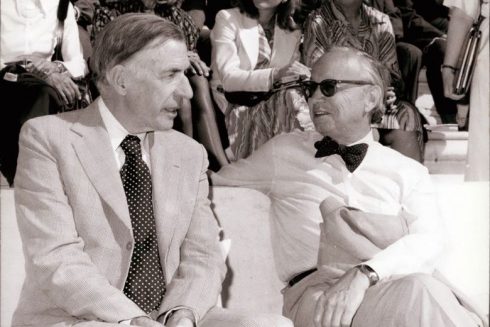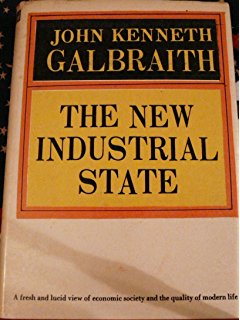ELUDING MY NEMESIS: JOHN KENNETH GALBRAITH

Authors John Kenneth Galbraith and Arthur Schlesinger, Jr.
By BOB VICKREY
Upon entering the Presidential Suite of the Charles Hotel in Cambridge, Massachusetts, I was immediately struck by the imposing figure of famed economist John Kenneth Galbraith engaged in conversation with renowned historian Arthur M. Schlesinger, Jr.
Galbraith’s towering presence at six-feet-nine made me momentarily forget that this man of 90 plus-years was still making the rounds at publishing events. It was almost twenty years ago when he was the guest speaker at Houghton Mifflin’s national sales conference meeting.
During his long, illustrious career, many of his books had been published by our company and that evening’s cocktail party held in his honor afforded us an opportunity to meet the former Ambassador to India and winner of the Presidential Medal of Freedom.
But what made the evening an even more august occasion was the presence of Galbraith’s longtime friend, the distinguished Mr. Schlesinger, who had been a Kennedy family confidante and biographer. Our company had also been responsible for publishing many of his finest works, including “Robert F. Kennedy and His Times.”
The two old friends spent a good part of the evening visiting with each other when not being interrupted by Houghton staff members who came by to greet them.
Our publicity director found me at my usual station during most cocktail parties—hiding behind a large banana tree leaf in the corner of the room. She asked, “Would you like to meet Ken?” Ken? I could hardly imagine approaching the celebrated author and longtime Harvard prof without greeting him properly as “Professor Galbraith.”
I had already decided that offering Mr. Galbraith my candid confession concerning the tranquilizing effect his books had always seemed to have on me was not a sound diplomatic option—nor one that would be in my company’s best interests.
If I could have been completely candid with “ol’Ken,” I would have finally expressed my pleasure in meeting the man who had been solely responsible for curing my college insomnia, after spending endless nights snoozing through his bestselling book, “The New Industrial State.” I had managed to plod through portions of his economics classic only after discovering that Cliff Notes focused primarily on fiction titles.

In a sudden flashback, I remembered waking up in the middle of the night in my college dorm room with his hefty tome pressed hard against my face, after once again falling asleep attempting to slog through his infinite treatise. The book’s edges had left deep creases across my forehead and a wide crevice down the bridge of my nose. In the most literal sense, I suppose I could honestly express to him what a deep impression his books had made on me.
The following morning there were still traces of those lines across my nose as I groggily slapped cold water on my face, attempting to erase the memory of processing terms like “Nash equilibrium,” regressive tax” and “oligopoly”. I had even decided the previous night that “Laffer curve” was surely a method that television sitcom writers used to determine whether their jokes were funny.
Of course, these shortcomings in the economics field had once again exposed my checkered academic past that have stalked me since the day the Baylor University dean of students summoned me to his office during my second junior year. He wagged his finger in my direction and firmly instructed: “Mr. Vickrey, you need to commit yourself to a field you can handle! Have you ever considered journalism?”
So, what could I possibly have to say to Professor Galbraith after I shook his hand? Would he be even slightly amused to learn that I had always been under the mistaken impression that Adam Smith was once the second baseman for the Chicago White Sox instead of the architect of modern economics?
And I assumed the man who endorsed post-Keynesian economics would likely cringe when he discovered that I once confused John Maynard Keynes with the drummer from Led Zeppelin. My bad, Ken!
I ultimately chose to simply admire the two celebrated scholars from afar and slip back into my rightful place behind the big banana leaf in the far corner of the room. There I found two of my favorite colleagues hiding in my secret spot. But I was happy to have some company and extremely relieved to learn there were two other people in the room who didn’t know a “Laffer curve” from an “inside slider.”
Bob Vickrey is a writer whose columns appear in several newspapers including the Houston Chronicle and the Waco Tribune-Herald. He lives in Pacific Palisades, California.
Comments
Leave a Reply
You must be logged in to post a comment.



